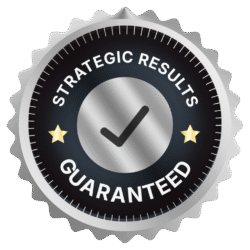Why Strategic Growth Requires Patience and Precision
In a fast-paced world where instant gratification is the norm, businesses often chase rapid expansion strategies, expecting immediate results. While quick-win tactics—like flash campaigns or aggressive discounting—can yield a surge of leads and short-term revenue, they rarely sustain growth over the long haul. Strategic growth demands a balance of patience and precision, combining thoughtful planning, measured execution, and continuous adaptation. In this post, we’ll explore why a deliberate approach to scaling your business outperforms impulsive, high-volume tactics and how to implement a patient, precise growth strategy that delivers lasting success.
1. The Pitfalls of Rushed Growth
Before diving into the principles of a patient, precise strategy, let’s examine common pitfalls when businesses rush to expand:
- Resource Strain and Burnout
Chasing rapid growth often means taking on more work than existing processes or teams can handle. When you scale headcount, marketing spend, or product lines without solid operational foundations, staff burn out, quality erodes, and customer experience suffers. For example, onboarding a flood of clients without refining service protocols can lead to missed deadlines, inconsistent output, and negative reviews that undermine your brand. - Diluted Brand Identity
In the frenzy to capture market share, businesses may compromise on messaging or stretch into markets that don’t align with their core values. A premium service known for personalized attention risks losing credibility if it starts adopting mass-market tactics—like generic promotions or broad, untargeted advertising—to boost lead counts. When your unique brand promise gets watered down, customer trust deteriorates and profitability declines. - Poor Financial Discipline
Rapid growth often entails heavy spending on marketing, staffing, or technology before revenue streams stabilize. When these investments aren’t guided by clear ROI metrics, you risk depleting cash reserves and facing crippling cash flow issues. Companies that chase “growth at all costs” without monitoring key financial metrics—gross margins, customer acquisition costs, and payback periods—frequently find themselves unable to sustain expansion. - Missed Opportunities Due to Lack of Focus
When everything is a priority, nothing truly is. Businesses that pursue multiple growth avenues simultaneously—new product lines, multiple geographic markets, and diverse customer segments—often spread themselves too thin. As a result, they fail to become leaders in any one area. Instead of owning a niche or honing a singular competitive advantage, they become a “jack of all trades, master of none.”
These pitfalls highlight why patience and precision are essential—slowing down long enough to build robust foundations ensures that growth is not only achieved but also maintained.
2. Defining Patience: Building on a Solid Foundation
Patience in strategic growth isn’t about procrastination; it’s about establishing durable structures before scaling. Key steps include:
A. Perfect Core Processes
- Operational Efficiency: Document and optimize every process—from lead intake and sales calls to fulfillment and customer support. Use process mapping or simple SOPs (Standard Operating Procedures) to ensure consistency. Only when your system runs smoothly under current demand should you scale up volumes.
- Quality Control Mechanisms: Implement checkpoints—automated or manual—that catch errors before they reach customers. This could be QA (quality assurance) checklists, peer reviews, or satisfaction surveys. By embedding quality controls early, you avoid scaling flawed processes.
B. Cultivate a Strong Company Culture
- Team Alignment: Ensure every team member understands the company’s mission, values, and long-term vision. When you hire or promote, seek cultural fit as much as technical skill. A cohesive team communicates better and adapts faster during growth phases.
- Leadership Development: Invest time in training managers and department heads to lead effectively. Strong leadership funnels down to empowered employees who can handle increased responsibility without constant supervision.
C. Validate Market Fit and Pricing
- Customer Feedback Loops: Before expanding, validate that your core offering truly resonates with your target market. Conduct in-depth interviews, surveys, or beta programs. Use this feedback to refine product features, pricing, and positioning. Only when customers consistently express delight (as measured by high Net Promoter Scores or repeat purchase rates) should you consider taking on more volume.
- Competitive Analysis: Understand your unique value proposition relative to competitors. Being clear about what sets you apart prevents you from chasing markets where you don’t have a distinct advantage.
Patience in these foundational areas pays dividends by reducing the risk of scaling unstable or misaligned operations.
3. Embodying Precision: Targeted, Data-Driven Expansion
Precision involves making strategic growth moves based on reliable data and clear criteria. Achieve precision by:
A. Segmented Market Testing
- Pilot Programs: Launch small-scale tests when entering new regions or customer segments. Maintain a controlled budget—using 5–10% of your marketing or deployment resources—and measure outcomes against predefined KPIs such as conversion rates, customer satisfaction, and retention. If a pilot underperforms, iterate quickly or abort before scaling.
- Localized Messaging: Tailor marketing and sales messages to local nuances—language, culture, or competitive landscape. Precision messaging yields higher engagement and lower acquisition costs compared to broad, one-size-fits-all approaches.
B. Data-Backed Decision-Making
- Key Metrics Dashboard: Track metrics that matter—Customer Acquisition Cost (CAC), Lifetime Value (LTV), Churn Rate, and Customer Satisfaction (CSAT). Establish thresholds that gate further investment. For instance, if CAC/LTV ratio exceeds a certain number, pause additional ad spend until you optimize the funnel.
- Regular Performance Reviews: Hold bi-weekly or monthly strategy sessions to examine leading indicators—website traffic quality, lead velocity, and sales cycle length. Use trend analyses to spot early warning signs that a segment or channel isn’t scaling as expected.
C. Balanced Growth Portfolio
- Core vs. Adjacent Markets: Allocate resources with a blend of low-risk and higher-risk initiatives. “Core” markets are well-understood segments where you dominate, warranting larger, steadier investment. “Adjacent” markets—similar customer profiles or neighboring geographies—can receive smaller, exploratory budgets. This balanced approach hedges risk: core markets fuel predictable revenue while adjacent tests uncover new growth opportunities.
- Channel Diversification: Rather than relying exclusively on one acquisition channel (e.g., paid search), invest across a mix: content marketing, referral partnerships, direct sales, and events. Diversification safeguards against platform-specific disruptions—changes in search algorithms, ad costs, or social media policies.
Precision growth ensures that each dollar spent moves you measurably closer to strategic objectives while minimizing waste.
4. Aligning Teams and Resources With Growth Plans
Even the most patient, precise strategy falters without proper execution by aligned teams. To facilitate cohesive growth:
A. Cross-Functional Collaboration
- Integrated Roadmaps: Develop a shared growth roadmap that outlines objectives and responsibilities across departments—marketing, sales, product, operations, and finance. Transparency in plans ensures that each team understands how their work contributes to overarching goals and can coordinate timelines.
- Regular Checkpoints: Schedule cross-departmental stand-ups or weekly syncs to address bottlenecks, share insights, and adjust priorities. If marketing campaigns generate spikes in lead volume, operations must scale staffing or fulfillment processes accordingly—communication is key.
B. Capacity Planning
- Scalable Team Structures: Use a modular staffing model—core full-time employees supplemented by contract specialists or outsourced partners when demand surges. This flexibility prevents permanent overhead spikes while maintaining agility during peak growth periods.
- Technology and Tools: Invest in tools that grow with scale—cloud-based CRMs, marketing automation platforms, and collaborative project management systems. Ensure data flows seamlessly across tools to maintain visibility and avoid siloed information.
C. Skill Development and Training
- Continuous Learning: Encourage ongoing training in data analytics, customer engagement best practices, and emerging growth channels. An informed team can adapt faster and contribute new ideas for strategic refinement.
- Leadership Empowerment: Delegate decision-making authority to team leads who manage specific growth initiatives—allowing them to optimize quickly without waiting for top-down approvals. Empowered leaders respond more swiftly to market signals.
Aligned teams and flexible resources turn strategic plans into actionable, coordinated efforts—ensuring precision at every operational level.
5. Balancing Short-Term Wins Within a Long-Term Framework
While patience underpins long-term strategy, it doesn’t mean ignoring opportunities for immediate impact. Instead, integrate short-term wins within your overarching framework:
A. Tactical Campaigns as Accelerators
- Launch Targeted Promotions: Time-limited offers or seasonal campaigns can inject new revenue streams, fund subsequent strategic investments, or clear inventory. Align these tactics with broader marketing themes—for example, a “Spring Refresh” campaign that ties into a long-term brand positioning around rejuvenation and quality.
- Micro-Experiments: Use small ad spends or A/B tests to validate messaging ideas, creative assets, or pricing tiers. Only roll out successful elements to larger audiences, ensuring precision even in short-term bursts.
B. Monitoring Funnel Health
- Lead Velocity vs. Capacity: If a fast campaign floods your funnel, ensure your operations and support teams can handle increased volume. Implement “soft caps” on lead generation budgets if processing capacity is limited, preventing ‘leads stranded’ scenarios where prospects receive no follow-up due to overwhelm.
- Revenue vs. Profit Focus: Avoid chasing top-line growth at the expense of margins. Track contribution margins for each campaign and product line—ensuring that quick wins don’t undercut long-term profitability.
Integrating short-term tactics within a patient, precise strategy amplifies growth while safeguarding stability.
6. Embracing Continual Learning and Evolution
A strategic growth plan isn’t set-and-forget. Market conditions shift, customer preferences evolve, and new competitors emerge. To remain resilient:
A. Regular Environmental Scans
- Industry Trends: Dedicate time monthly or quarterly to review industry reports, competitor analyses, and emerging technologies. Early awareness of shifts—like new regulatory changes or disruptive business models—allows proactive adjustments.
- Customer Voice: Collect ongoing feedback through surveys, interviews, or social media listening. When customer pain points or desires shift, update product features, messaging, or service offerings accordingly.
B. Iterative Strategy Adjustments
- Quarterly Strategy Reviews: Every three months, revisit growth objectives, performance metrics, and resource allocations. Eliminate underperforming initiatives and reallocate budget to promising areas without waiting for end-of-year reviews.
- Agile Project Management: Apply agile methodologies for marketing and product development—use sprint cycles, backlog prioritization, and rapid prototyping to iterate quickly while keeping alignment with long-term goals.
Continual learning ensures that your strategy remains precise, even as external factors evolve.
Final Thoughts
Strategic growth requires a delicate blend of patience and precision: patience to build robust foundations, refine processes, and cultivate strong brand equity; precision to expand into new markets with data-driven insights, target the right audiences, and execute with operational excellence. By resisting the temptation to chase every short-term opportunity in isolation, and instead focusing on measured, adaptable strategies, you create an engine for sustainable success.
As you implement this approach, remember:
- Solidify core processes before scaling.
- Use data to guide every expansion decision.
- Align teams and resources around clear growth objectives.
- Integrate quick wins within a long-term framework.
- Commit to continuous learning and iteration.
When patience and precision guide your growth journey, you avoid the pitfalls of overreach, maintain high-quality standards, and build a resilient organization capable of thriving through market cycles. Embrace this mindset, and watch your business evolve from short-lived spikes to enduring, strategic success.









